|
|
|
Sort Order |
|
|
|
Items / Page
|
|
|
|
|
|
|
| Srl | Item |
| 1 |
ID:
142646
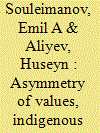

|
|
|
|
|
| Summary/Abstract |
This article fills the gap in existing scholarship on asymmetric conflict, indigenous forces, and how socio-cultural codes shape the dynamics and outcomes of conflict transformation. Specifically, it identifies three key socio-cultural values commonplace in honorific societies: retaliation, hospitality, and silence. As sources of effective pro-insurgent violent mobilisation and support from among the local population, these values provide insurgents with an asymmetric advantage over much stronger incumbents. Using the case studies of the two Russian counterinsurgencies in Chechnya, the article shows the mechanisms on the ground through which Moscow’s deployment of indigenous forces against insurgents helped to stem the tide of conflict, reversing the insurgents’ initial advantage in terms of asymmetry of values.
|
|
|
|
|
|
|
|
|
|
|
|
|
|
|
|
| 2 |
ID:
142115
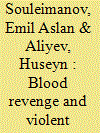

|
|
|
|
|
| Summary/Abstract |
Despite a considerable amount of ethnographic research into the phenomena of blood revenge and blood feud, little is known about the role of blood revenge in political violence, armed conflict, and irregular war. Yet blood revenge—widespread among many conflict-affected societies of the Middle East, North Africa, and beyond—is not confined to the realm of communal infighting, as previous research has presumed. An empirical analysis of Russia's two counterinsurgency campaigns in Chechnya suggests that the practice of blood revenge has functioned as an important mechanism in encouraging violent mobilization in the local population against the Russian troops and their Chechen proxies. The need to exact blood revenge has taken precedence over an individual's political views, or lack thereof. Triggered by the loss of a relative or humiliation, many apolitical Chechens who initially sought to avoid involvement in the hostilities or who had been skeptical of the insurgency mobilized to exact blood revenge to restore their individual and clan honor. Blood revenge functions as an effective, yet heavily underexplored, grievance-based mechanism encouraging violent mobilization in irregular wars.
|
|
|
|
|
|
|
|
|
|
|
|
|
|
|
|
| 3 |
ID:
164823
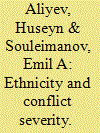

|
|
|
|
|
| Summary/Abstract |
How does the presence of armed pro-regime groups affect conflict lethality? This study examines the relationship between ethnicity, militia violence and conflict lethality in civil wars. We emphasise that differences in whether pro-regime militias were recruited in accordance with their ethnicity or not are critical in their influence upon conflict lethality, which we estimate in battlefield deaths. To that end, we categorise militias into groups recruited on their ethnic basis (co-ethnic militias) and those recruited regardless of their ethnicity (non-ethnic militias). We hypothesise that conflicts are more lethal when non-ethnic militias are involved. We link higher number of battle-deaths in conflicts with non-ethnic militias with the militia use of one-sided violence against civilians. Co-ethnic militias – that is militias recruited from the same ethnicity as rebels – are deployed amongst their co-ethnics and therefore tend to target civilians less than non-ethnic militias. This militia–civilian relationship has direct impact on conflict severity. To test our hypotheses we conduct global statistical analysis of 84 intrastate conflicts from 1989 to 2014.
|
|
|
|
|
|
|
|
|
|
|
|
|
|
|
|
| 4 |
ID:
144773
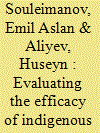

|
|
|
|
|
| Summary/Abstract |
This study seeks to identify factors conducive to the (in)efficacy of indigenous forces (IF) in counterinsurgency (COIN) operations in Russia’s republics of Chechnya and Dagestan. Empirically, it is the first study to offer an examination of the deployment of IF in the North Caucasus-based COIN. The findings of this article emphasize that the effectiveness of COIN in Chechnya, unlike Dagestan, is conditioned by a number of factors pertaining to the structural and organizational characteristics of IF. Of these, the IF’s experience as former insurgents, their access to insider information, and their loyalty to incumbents – often maintained by the threat of collective punishment – have proven decisive for a relatively successful COIN in Chechnya.
|
|
|
|
|
|
|
|
|
|
|
|
|
|
|
|
| 5 |
ID:
174108
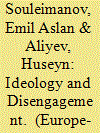

|
|
|
|
|
| Summary/Abstract |
Disengagement from militant groups has often been explained in individual terms such as battle fatigue or the desire to rejoin family and friends. We seek to examine empirically which other factors, beyond individual-level determinants, have influenced disengagement processes among militants belonging to different types of Chechen militant organisations. Drawing empirical insights from unique in-depth interviews with former members of the Chechen insurgency, their relatives, eyewitnesses to the Chechen wars and experts with first-hand knowledge of the researched phenomena, this study examines disengagement among jihadist and nationalist Chechen militants. Focusing on group-level factors, such as the capacity to resist external pressures, the use of violence, in-group social bonds and group cohesion, this article demonstrates that disengagement has been a less viable course of action for Chechen jihadists than for nationalist militants.
|
|
|
|
|
|
|
|
|
|
|
|
|
|
|
|
| 6 |
ID:
154385
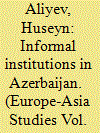

|
|
|
|
|
| Summary/Abstract |
Research on informal aspects of the post-communist economy and political institutions has developed rapidly since the collapse of the Soviet Union. While there is no lack in research on informal practices in Russia and other Eastern European countries, comprehensive empirical investigations of informality in peripheral regions of the former Soviet Union—such as the Caucasus and Central Asia—are still rare. This article aims to fill this gap by providing an evidence-based empirical account of informal practices in post-Soviet Azerbaijan. Drawing its empirical data from a two-decade-long ethnographic participant observation carried out in various locales of Azerbaijan’s capital, Baku, this study offers nuanced insights into the hitherto unexplored informal practice of tapsh.
|
|
|
|
|
|
|
|
|
|
|
|
|
|
|
|
| 7 |
ID:
139221
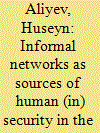

|
|
|
|
|
| Summary/Abstract |
In contrast to numerous studies on exogenous mechanisms of human security – such as the provision of human security by international actors – this study examines the role of informal networks in providing ‘freedoms from want’ and ‘freedoms from fear’ to the population. With the primary focus on post-communist South Caucasus (Armenia, Azerbaijan and Georgia) this article conducts a rigorous examination of informal networks’ critical function as sources of human (in)security since the breakup of the Soviet Union. Based on a combination of open-ended elite (expert) interviews, field observation and closed-ended survey data, this study demonstrates that apart from the informal networks’ crucial role in generating social capital and functioning as indispensable social safety nets, they also exacerbate human insecurity by cementing the traditions of clientelism and corruption that are deeply entrenched in the region.
|
|
|
|
|
|
|
|
|
|
|
|
|
|
|
|
| 8 |
ID:
163499
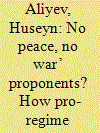

|
|
|
|
|
| Summary/Abstract |
Previous research on non-state actors involved in civil wars has tended to disregard the role of extra-dyad agents in influencing conflict outcomes. Little is known as to whether the presence of such extra-dyadic actors as pro-regime militias affects conflict termination and outcomes. This article develops and tests a number of hypotheses on the pro-government militias’ effect upon civil war outcomes. It proposes that pro-regime militias involved in intrastate conflicts tend to act as proponents of ‘no peace, no war’, favouring low-activity violence and ceasefires over other conflict outcomes. These hypotheses are examined using an expanded dataset on pro-government militias and armed conflict in a statistical analysis of 229 civil war episodes from 1991 to 2015. These findings shed new light on the role of extra-state actors in civil wars.
|
|
|
|
|
|
|
|
|
|
|
|
|
|
|
|
| 9 |
ID:
154472
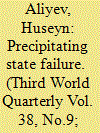

|
|
|
|
|
| Summary/Abstract |
This article examines whether the incidence of civil wars and the presence of violent non-state actors have an effect on state failure. Research on failed states has thus far prioritised armed conflicts as one of the key causes of state failure. This study challenges that claim and posits that civil war incidence has limited impact on the transition from fragility to failure. Global quantitative analysis of state failure processes from 1995 to 2014 shows that although armed conflicts are widespread in failed states, civil violence does not lead to state failure and large numbers of failed states become engulfed by civil war only after the failure occurs. By contrast, this study demonstrates a direct link between the presence of violent non-state actors and state failure.
|
|
|
|
|
|
|
|
|
|
|
|
|
|
|
|
| 10 |
ID:
188083
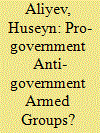

|
|
|
|
|
| Summary/Abstract |
This study challenges the presentation of non-state armed groups as divided into anti-government rebels and pro-government proxies and proposes that some pro-government armed groups maintain explicit anti-government rhetoric. It is this anti-government agenda that enables “pro-government” groups to successfully recruit their members and to advance their interests. From Iraq’s Shiite militias to Lebanon’s Hezbollah and Afghan Uzbek warlords, there are numerous armed groups which, on the one hand, officially maintain pro-government stance and, on the other hand, explicitly criticize, oppose and challenge the state. On a theoretical level, this study seeks to demonstrate that a “pro-government anti-government” group is a distinct category of non-state armed groups that neither directly engages in armed confrontation with the state nor complies with its agenda and policies or fully accepts its legitimacy. On an empirical level, this paper explores why individuals mobilize for pro-government anti-government armed groups. Unique micro-level interview data with members of volunteer militia battalions in Ukraine are employed to provide insights into the functioning of pro-government anti-government militants. Drawing upon its empirical findings, this study proposes that pro-government “government challengers” emerge and persist because these groups are more efficient than the government in the provision of security and in promoting the incumbent’s ideology.
|
|
|
|
|
|
|
|
|
|
|
|
|
|
|
|
| 11 |
ID:
172194
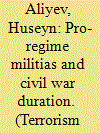

|
|
|
|
|
| Summary/Abstract |
Research on civil war duration has tended to focus almost exclusively on governments and rebels as actors accounting for the longevity of armed conflicts. The impact of extra-dyad actors has thus far been absent from the analysis of factors contributing to civil war duration. This study contributes to both research on civil war duration and multi-actor models of intrastate conflicts by extending the analysis beyond the government-rebel dichotomy. With the focus on pro-regime militias, this article investigates whether the deployment of extra-dyad actors increases the duration of civil wars.
Survival analysis models conducted on the sample of 250 civil war episodes between 1991 and 2015 reveal that participation of pro-regime militias in intrastate warfare has consistent association with the incidence of longer civil wars.
|
|
|
|
|
|
|
|
|
|
|
|
|
|
|
|
| 12 |
ID:
149481


|
|
|
|
|
| Summary/Abstract |
This article challenges the well-established presentation within conflict studies of paramilitary organizations as state-manipulated death squads or self-defence groups, and argues that some present-day militias extend their functions well beyond the role of shadowy pro-regime enforcers. Drawing its empirical insights from Ukrainian pro-government volunteer battalions and supporting its findings with empirical observations from other parts of the world, the article posits that the rise of powerful militia organizations acting in parallel with the state makes it imperative to revisit the theory and typology of paramilitary violence. The key theoretical argument of the article is that ‘state-parallel’ militias differ qualitatively from the ‘state-manipulated’ paramilitaries that are typical of the Cold War period. The article shows that although ‘state-parallel’ paramilitaries are not a new phenomenon, they have thus far remained critically understudied and undertheorized.
|
|
|
|
|
|
|
|
|
|
|
|
|
|
|
|
| 13 |
ID:
191477
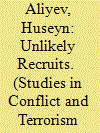

|
|
|
|
|
| Summary/Abstract |
There is little research on why smaller ethnic groups with no political stakes in the conflict take part in civil wars. There is even less understanding as to why members of small ethnicities join ideologically distant conflict participants to fight against an enemy that does not directly threaten their ethnic security. This study describes these ethnic minority combatants as “unlikely recruits.” It argues that members of politically irrelevant minorities join stronger conflict participants—either governments or rebels—seeking to protect their ethnic interests from both their prospective hosts and their foes. Although the “unlikely recruits” have minimal grievances against enemies of their hosts and they receive limited participation rewards, forging an alliance with an actor which is likely to offer the highest benefits is sufficient to overcome the collective action problem. Recruiting members of smaller ethnic minorities in the context of ethnic civil wars allows armed actors to strengthen their image of ethnic diversity and all-inclusiveness, as well as to benefit from material resources provided by the “unlikely recruits.” These arguments are empirically tested using new evidence from Ukraine that offers a rare glimpse into the dynamics of politically irrelevant minorities’ participation in civil wars.
|
|
|
|
|
|
|
|
|
|
|
|
|
|
|
|
| 14 |
ID:
168895
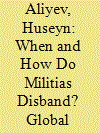

|
|
|
|
|
| Summary/Abstract |
The research to date on pro-governm`ent militias demonstrates that numerous pro-regime militia groups were actively deployed in civil wars over the last half a century. As hundreds of militia groups emerged amid civil warfare, hundreds more were disbanded, integrated into regular military, or transformed into political forces. This study seeks to improve our understanding of global patterns of militia demobilization. In contrast to the growing body of literature that explores the emergence of militias or examines their relationship with the state, studies on the demise of pro-government militias are notable by their absence. Statistical analysis of 220 pro-government militias involved in seventy-five civil wars from 1981 to 2011, based on a recent database of pro-government militias, demonstrates that the disappearance of militias has little to do with the termination of armed conflict. This study is the first to investigate when and under which conditions militias created to assist governments in fighting civil wars disband.
|
|
|
|
|
|
|
|
|
|
|
|
|
|
|
|
|
|
|
|
|